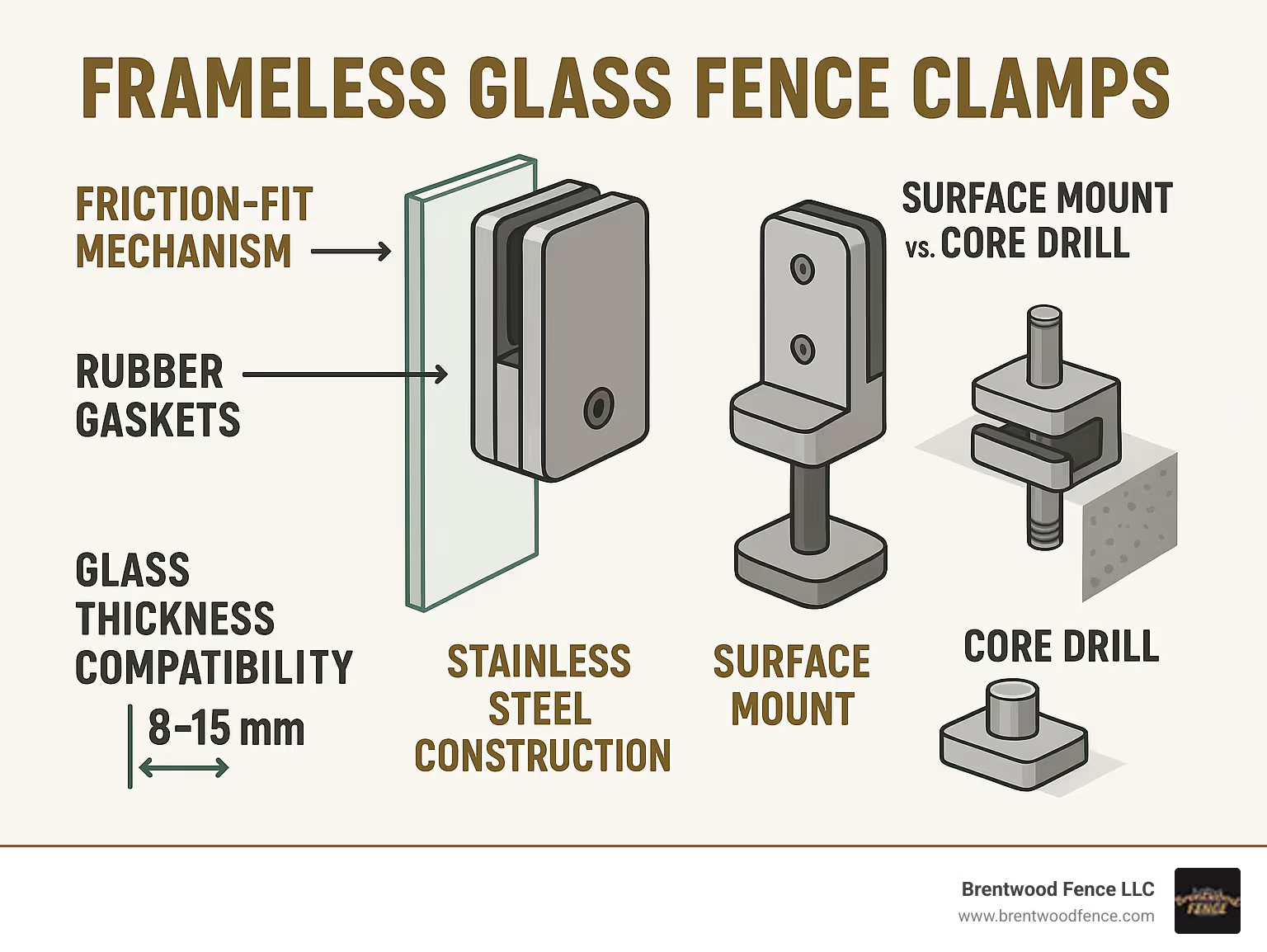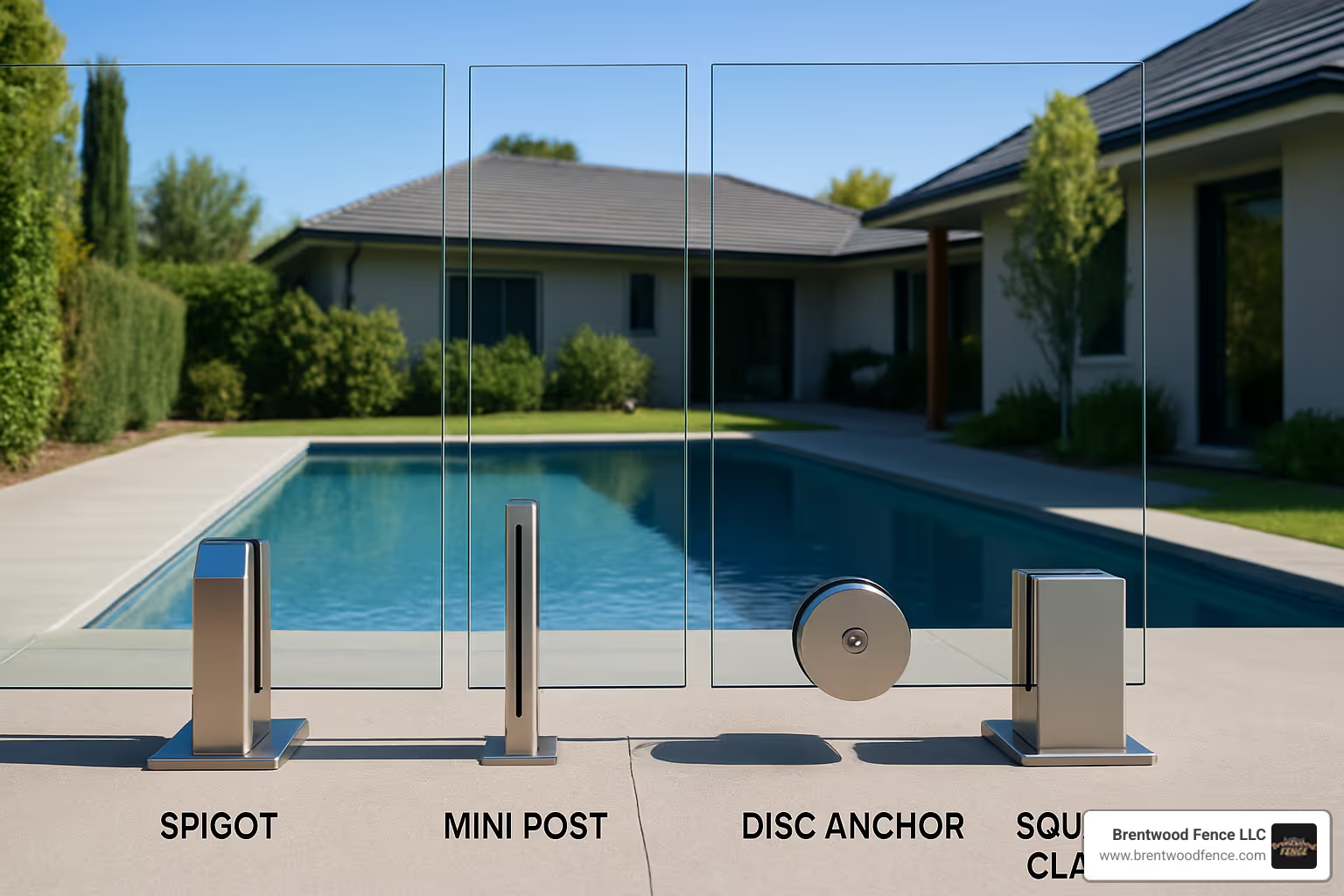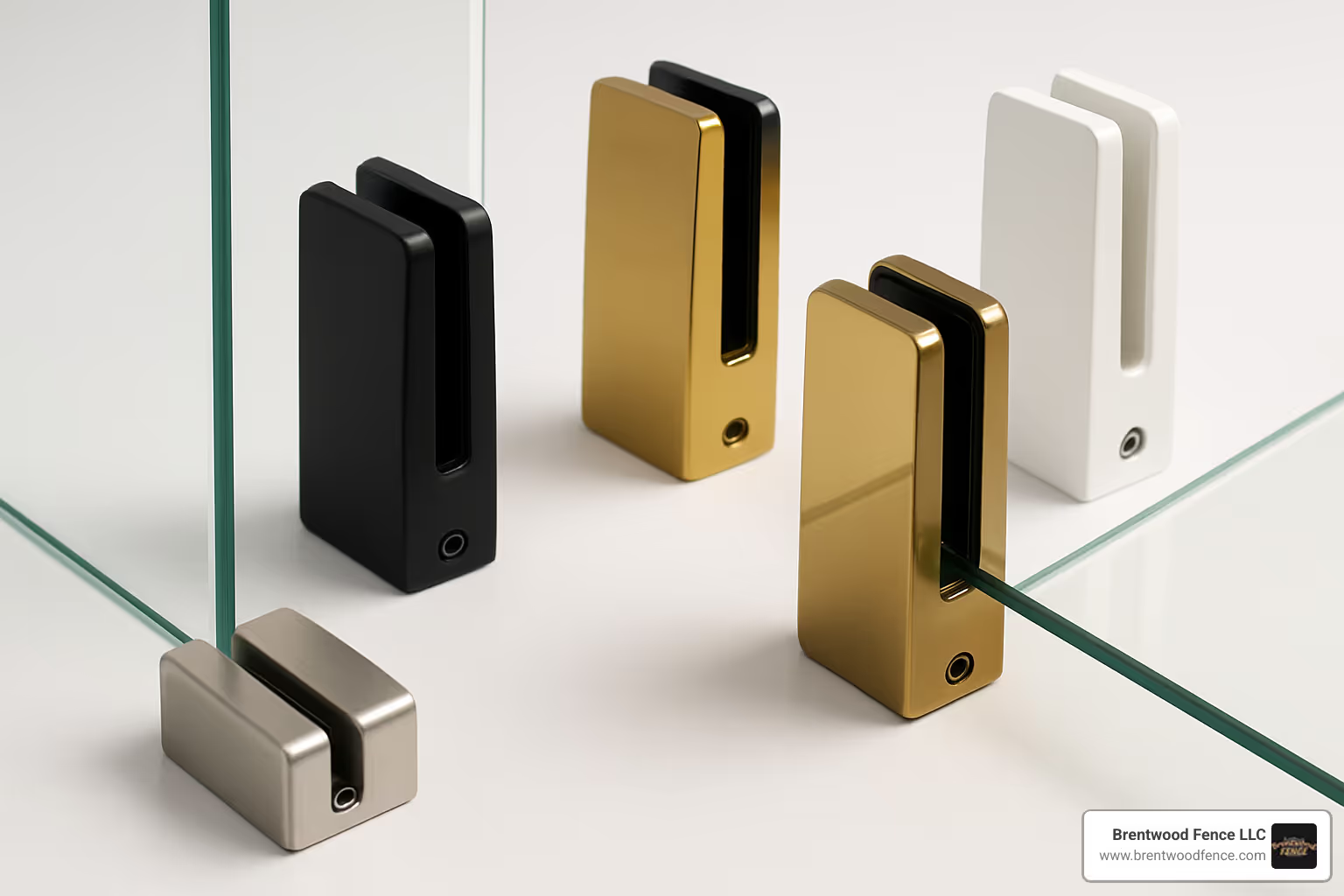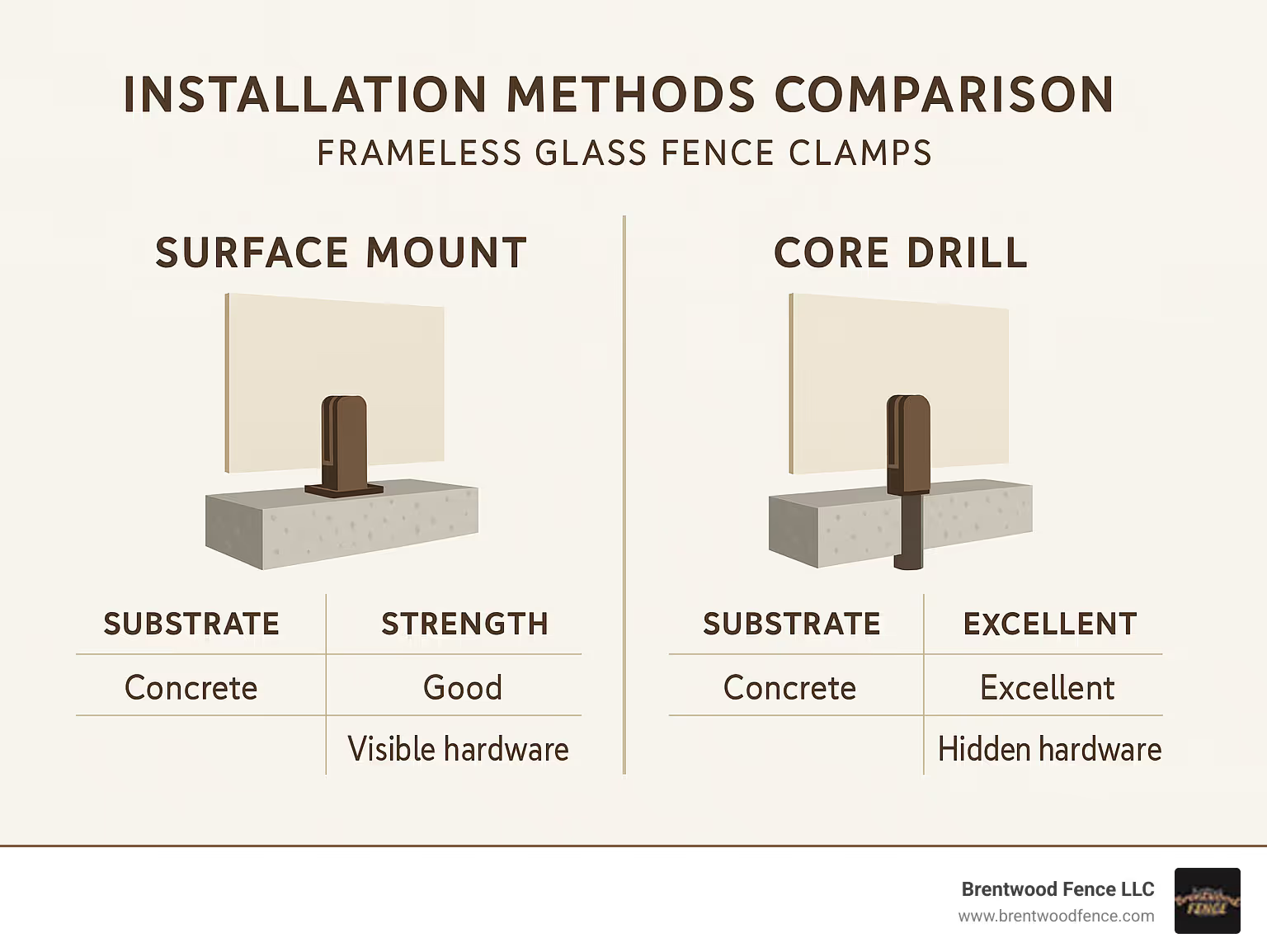Blog Content
22
Jun
2025

Frameless glass fence clamps are specialized hardware components that secure glass panels without drilling holes through the glass itself. These innovative mounting systems use friction-fit technology and adjustable jaws to grip glass panels securely while creating unobstructed views around pools, balconies, and property perimeters.
Quick Overview of Frameless Glass Fence Clamp Options:
Key Benefits:
Traditional fence posts can block your view and create visual clutter. But as one industry expert noted: "Frameless fencing is the ultimate in fencing systems, combining safety, strength, security, style, and spaciousness."
The secret lies in the clamp technology. Marine-grade 316 stainless steel clamps resist corrosion from pool chemicals and coastal salt air, while friction-fit designs eliminate the risk of glass breakage during installation. Most systems require at least 4 clamps per panel (2 on each side) and can achieve clear spans up to 6 feet between mounting points.
Whether you're protecting a pool area, securing a balcony, or creating a wind screen, the right clamp system makes all the difference in both safety and aesthetics. Contact Brentwood Fence for professional glass fencing installation in NH, ME and MA.

Ever wondered how those sleek glass panels stay perfectly in place without any visible screws or holes? The secret is all in the friction-fit technology that makes frameless glass fence clamps so brilliant.
Think of it like a sophisticated vise grip. These clamps use adjustable jaws lined with rubber gaskets to grab onto the edges of your glass panels. When you tighten the clamp screws to the right torque setting, the rubber creates enough friction to hold everything rock-solid - even when the wind picks up.
The system transfers all that force from the glass panel through the clamp body and into whatever you've mounted it to - your concrete deck, timber posts, or steel framework. Those rubber gaskets prevent metal parts from touching the glass directly (which could cause cracks), spread the pressure evenly, and create a waterproof seal.
The beauty is that there's no drilling through the glass required. This means faster installation, less risk of breakage, and panels that maintain their full strength.
Frameless glass fence clamps are specialized hardware designed to hold glass panels securely without traditional frames. They come in several types:
Spigots are floor-mounted clamps that can be surface-mounted on your deck or core-drilled into concrete for an ultra-clean look. Clips work with existing posts or walls to cradle the glass panels.
Mini posts are slim vertical clamps that barely show themselves while doing all the heavy lifting, perfect for that modern, almost-floating-glass effect. Disc anchors bring an industrial vibe with their point-fixing design using minimal hardware.
None of these systems require drilling holes through your expensive glass panels. They all grip the edges using controlled pressure and friction, eliminating cracking risk during installation.
Once you experience frameless glass fencing, it's hard to go back to traditional options.
Panoramic views are the obvious winner. Traditional fence posts can block nearly a third of your view, but frameless systems get out of the way completely. Whether you're admiring your landscaping or watching the kids in the pool, nothing interrupts the experience.
Wind protection might surprise you as a benefit. Solid glass panels create an effective windbreak that traditional slat or mesh fencing simply can't match.
Child safety becomes effortless with smooth glass surfaces. Pool safety codes require barriers that kids can't climb, and glass panels eliminate the handholds that little ones are so good at finding on traditional fences.
Property value gets a nice boost too. Real estate professionals consistently tell us that frameless glass fencing appeals to buyers more than traditional options.
As one of our recent clients put it: "We wanted our pool area to feel safe but not like a prison yard. The frameless glass gives us both - protection and beauty rolled into one."
Choosing the right frameless glass fence clamps can feel overwhelming at first, but it doesn't have to be. Think of it like picking the right tool for the job - each type has its sweet spot where it really shines.
The main clamp families break down into four categories: glass spigots for that clean floor-mounted look, mini posts for ultra-modern aesthetics, disc anchors when you want industrial chic, and square or round clamps for versatile mounting options. Let's explore what makes each one special.

Glass spigots are the go-to choice when you want that seamless glass wall effect. These floor-mounted clamps grip your glass panels from the bottom, creating an uninterrupted barrier that's perfect for pool areas.
Surface mount spigots are the easier installation option. They bolt directly onto your concrete patio, timber deck, or tile surface using expansion anchors or lag screws. No deep drilling required - just mark, drill, and mount. Most handle 12mm toughened glass beautifully, though you'll find models that work with glass from 1/2" to 9/16" thick.
Core mount spigots take things up a notch. These get inserted into holes drilled right into your concrete substrate, then secured with expanding cement or grout. The result? The mounting hardware practically disappears, giving you that ultra-clean look. It's more work upfront, but the payoff in aesthetics is huge.
The 2205 duplex stainless steel construction means these spigots will outlast your deck. They're built for the long haul, especially in tough environments where traditional posts would rust or deteriorate.
Mini posts are where frameless glass technology gets really exciting. These slim-profile clamps have such a minimal footprint that they practically vanish into your design.
The beauty of the channel-less system is that there's no continuous rail connecting everything. Each mini post works independently, so you get cleaner sight lines and more flexibility in your layout. This is especially handy on floating decks where traditional channel systems can interfere with drainage or cause problems when the deck moves with temperature changes.
Gutter bracket compatibility makes mini posts perfect for waterproof deck systems. The brackets are designed to handle deck movement while keeping your glass panels perfectly aligned. No more worrying about seasonal settling throwing everything out of whack.
The adjustable features are a real lifesaver. If your deck decides to shift a bit over time (and they all do), you can fine-tune the clamps without pulling out the glass panels. It's like having a built-in insurance policy for your installation.
Disc anchors are for folks who appreciate that modern industrial aesthetic. These point-fixing systems use a neat 50mm diameter disc with a 30mm body - clean, simple, and surprisingly strong.
The face-fix installation couldn't be more straightforward. Mount the disc directly to your wall, planter, or structural element. No core drilling needed, but you still get rock-solid attachment for your glass panels.
Through-bolt options are available when you need maximum strength. The industrial look actually becomes part of your design rather than something you're trying to hide. It's particularly striking in commercial settings or contemporary homes where the hardware adds to the overall aesthetic.
These are the workhorses of the frameless glass world. Square and round clamps might not be the flashiest option, but they're incredibly versatile and reliable.
Post-mount versions are perfect for retrofitting existing structures. Got wood posts, metal posts, or structural columns? These clamps will adapt to work with what you already have. The rubber gaskets are sized specifically for different glass thicknesses (typically 3/8" to 1/2"), so you get proper grip without putting stress on your glass.
Wall-mount options shine for balconies, stairs, and anywhere you need to attach glass panels to building surfaces. The Marine Grade 316 stainless steel construction means they'll handle whatever weather throws at them, even in harsh coastal environments.
The rubber gaskets do double duty - they provide the grip and protect your glass from direct metal contact. It's simple engineering that just works.
For detailed installation guidance and professional support, check out our Glass Fencing Installation Services page.
When you're investing in frameless glass fence clamps, the materials and finishes you choose today will determine how your fence looks and performs for decades to come. Living here in New England, we've seen how harsh winters, salty coastal air, and pool chemicals can make or break outdoor hardware.

316 marine grade stainless steel is the superhero of outdoor metals. While regular 304 stainless steel might look similar, 316 grade has molybdenum, which makes all the difference when your clamps face the real world.
Pool chemicals are no joke. That chlorine keeping your water sparkling clean is incredibly corrosive to most metals. We've seen beautiful fences turn into eyesores within just a few seasons when homeowners chose lesser grades of stainless steel. The 316 grade handles chlorine exposure that would pit and stain other materials.
Salt air travels farther than you think. Even miles from the ocean, Atlantic salt spray can still reach your property. One client in Concord, NH - about 50 miles inland - was amazed when we showed him the corrosion on his neighbor's regular stainless steel railings. The marine grade 316 we installed still looks pristine three years later.
Powder-coated aluminum brings different advantages. If you've watched installers struggle with heavy stainless steel components, you'll appreciate how much easier aluminum makes the job.
Color is where aluminum really shines. While stainless steel gives you that classic metallic look, powder-coated aluminum opens up a rainbow of possibilities. With over 40 standard color options, you can match your home's shutters or create bold contrasts.
Your wallet will appreciate aluminum too. Quality aluminum clamps typically run 20-30% less than their stainless steel cousins while still delivering excellent performance for most residential applications.
Physical Vapor Deposition (PVD) coatings bond at the molecular level to create finishes that are tougher than traditional powder coating.
Scratch resistance is where PVD really shows off. Regular powder coats can get scratched by pool equipment or furniture. PVD coatings are significantly harder and maintain their appearance even with daily wear and tear.
The investment in specialty coatings pays you back through reduced maintenance and that "new fence" appearance that lasts year after year.
Proper installation is crucial for both safety and performance of frameless glass fence clamps. The method you choose depends on your substrate, local codes, and aesthetic preferences.

Surface Mount Essentials for Frameless Glass Fence Clamps
Surface mounting is the most versatile installation method. It works on virtually any stable substrate and doesn't require specialized drilling equipment.
Anchoring Hardware: The key is selecting the right fasteners for your substrate. Expansion anchors work best in concrete, while lag screws are ideal for timber. Stainless steel fasteners are essential to prevent galvanic corrosion.
Concrete vs. Timber: Concrete provides the strongest base but requires masonry bits and proper anchors. Timber offers easier installation but may require additional blocking or reinforcement for high-wind areas.
The beauty of surface mounting is its reversibility. If you need to relocate or remove the fencing later, the substrate damage is minimal.
Core drilling provides the strongest possible connection by embedding the clamp directly into the substrate. This method is particularly popular for pool fencing where maximum security is required.
Expanding Cement: After inserting the clamp into the core-drilled hole, expanding cement creates a permanent, weatherproof seal. This prevents water infiltration that could cause freeze-thaw damage in our New England climate.
Drainage Considerations: Proper drainage around core-mounted clamps prevents water accumulation that could compromise the installation over time.
While core drilling requires more specialized equipment, the result is a virtually indestructible connection that will outlast the glass panels themselves.
One of the biggest advantages of modern frameless glass fence clamps is that they eliminate the need for holes in the glass panels. This reduces fabrication time, eliminates a potential failure point, and allows for easier panel replacement.
Hole-Free Systems: Friction-fit clamps grip the glass edges without penetration. This preserves the glass integrity and allows for adjustment even after installation.
Drilled Panel Options: Some applications still use through-glass bolting, particularly for very high wind loads or specific architectural requirements. However, these systems require precise fabrication and careful handling.
Fabrication Lead Times: Hole-free systems can often use stock glass panels, reducing lead times from weeks to days.
Safety compliance isn't optional - it's essential. Different applications have specific requirements that must be met.
Pool Fencing Requirements: Most jurisdictions require 1200mm (48") minimum height for pool barriers, with specific spacing requirements for any gaps. The glass must be toughened (tempered) and meet impact resistance standards.
Balustrade Codes: Balcony and stair railings typically require 1000mm (42") minimum height and must resist specific horizontal loads. The International Building Code (IBC) and International Residential Code (IRC) provide detailed requirements.
Wind Load Calculations: Coastal areas and high-rise applications require engineering calculations to ensure the clamp system can handle design wind loads.
For detailed compliance guidance, reference the ICC-ES report on glass clamp safety which provides comprehensive testing data and installation requirements.
Picking the right frameless glass fence clamps depends on your unique situation - and getting it right the first time saves both headaches and money down the road.
Your project location tells us almost everything about material requirements. Live within five miles of the ocean? Salt air can corrode lesser materials faster than you'd believe. That's why we always recommend marine-grade 316 stainless steel for anything near saltwater.
Pool areas present their own challenges. Chlorine exposure is relentless, making this one of the toughest environments for any metal component.
Glass thickness might seem minor, but it's crucial for clamp compatibility. Most residential applications work perfectly with 12mm toughened glass, which offers excellent strength while keeping costs reasonable. High-wind coastal areas often require stepping up to 15mm glass.
Your substrate type determines which installation methods are possible. Concrete gives you the most options - both surface mounting and core drilling work beautifully. Timber decking usually means surface mounting with quality lag screws.
Budget considerations go beyond just the initial purchase price. Marine-grade stainless steel costs more upfront than aluminum alternatives, but when you factor in replacement costs and maintenance time, the premium materials often cost less in the long run.
Even the best frameless glass fence clamps need some attention to stay looking their best. The good news is that proper care takes just minutes per month.
Fresh water is your best friend. A monthly rinse removes the salt deposits and pool chemicals that love to build up on metal surfaces. This simple step prevents most staining and corrosion issues.
For deeper cleaning, stick with mild dish soap and warm water. Harsh chemicals and abrasive cleaners might seem more effective, but they actually damage the protective surface layers.
Microfiber cloths and soft sponges are all you need for cleaning. They remove dirt and grime without scratching the surface. Those tiny scratches from abrasive pads become starting points for corrosion.
We've fixed enough botched installations to know exactly where things go wrong.
Under-torquing is probably the most common error. Those torque specifications aren't suggestions - they're engineering requirements. Too little torque means your clamps won't grip the glass properly. Too much torque can crack the glass or damage the clamp threads.
Never allow direct metal-to-glass contact. Those rubber gaskets aren't optional accessories - they're critical safety components. We've seen glass panels shatter from thermal stress when installers skipped the gaskets.
Uneven spacing might seem like just an aesthetic issue, but it creates real structural problems. Irregular spacing means some clamps carry more load than others, potentially leading to failure.
For detailed examples of proper installation techniques, check out our Frameless Glass Fencing case studies.
We get these questions almost daily from homeowners planning their glass fencing projects. Here are the answers that matter most when you're choosing frameless glass fence clamps.
For most homes around New Hampshire and Massachusetts, 12mm toughened glass hits the sweet spot perfectly. It's strong enough to handle our weather, works with virtually all clamp systems, and won't break your budget.
If you're dealing with serious wind exposure - maybe you're right on the coast or up on a hill - you might need to step up to 15mm glass. Commercial projects almost always go this route too. On the flip side, some protected residential areas can get away with 8mm to 10mm glass, which costs less but still meets safety codes.
Laminated glass options are worth considering if safety is your top priority. These panels stay together even when cracked, which gives extra peace of mind around pools where kids are playing. The standard thickness for laminated is usually 9/16 inch.
Here's the simple rule: never go with fewer than 4 clamps per panel - that's 2 clamps on each side. But depending on where you live and how big your panels are, you might need more.
For typical residential jobs, we space clamps about 600 to 800mm apart vertically. That works great for most situations and looks clean too. But if you're dealing with coastal winds or you're up high where the wind really whips around, you'll want clamps every 400 to 500mm instead.
The last thing you want is a glass panel that wobbles in the wind or, worse, fails completely. When in doubt, add an extra clamp or two - it's cheap insurance compared to replacing a panel.
Absolutely! This is one of the best things about surface-mount clamps - they're perfect for adding glass fencing to decks and patios you already have.
The key is making sure your existing structure is solid. Most concrete patios handle the extra load just fine. Timber decks work great too, as long as they're not already bouncy or showing signs of wear. You'll need the right fasteners - stainless steel lag screws for wood, expansion anchors for concrete.
If you've got a concrete patio and want the cleanest look possible, core drilling is still an option. You'll need access for the drilling equipment, but the result is worth it - the hardware disappears completely below the surface.
Before you start drilling anything, take a good look at your deck structure. Glass panels catch a lot of wind, and that force has to go somewhere. If your deck already sways or feels weak, you might need some reinforcement first. Better to handle that upfront than deal with problems later.
Choosing the right frameless glass fence clamps can transform your outdoor space from ordinary to extraordinary. After working with hundreds of homeowners across New Hampshire, Massachusetts, and Maine, we've seen how the right clamp system creates that perfect balance of safety and stunning views.
Your project planning should start with understanding your environment. Coastal properties need the corrosion resistance of 316 marine-grade stainless steel, while inland locations might do perfectly well with powder-coated aluminum options.
Safety always comes first in our approach. Pool fencing codes exist for good reason, and proper clamp selection ensures your family's protection while maintaining those precious sight lines. The engineering behind modern friction-fit systems is impressive - these clamps can handle significant wind loads while gripping glass panels securely without drilling holes.
The beauty of seamless views is what draws most people to frameless systems initially. But the real value comes from the combination of safety, durability, and property improvement.
At Brentwood Fence LLC, we bring decades of expertise to every frameless glass fencing project. We understand New England's unique challenges - from coastal salt air to harsh winters - and we know which clamp systems perform best in our climate.
Whether you're protecting a pool area, creating a wind barrier, or adding a modern balustrade, the right clamp system makes all the difference. Don't leave this important decision to chance.
Ready to see what frameless glass fencing can do for your property? Contact us today for a Free Fencing Installation Estimate and let's create something beautiful together.
Copyright 2022 Brentwood Fence | All Rights Reserved | Sitemap | Website by Plumb Development a Digital Marketing Agency